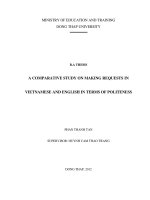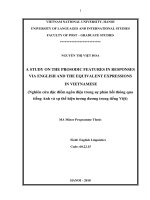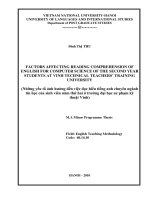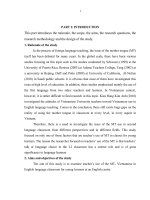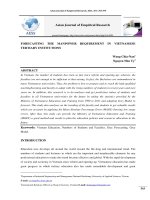Graduation Thesis Computer Science Finding the semantic similarity in Vietnamese
Bạn đang xem bản rút gọn của tài liệu. Xem và tải ngay bản đầy đủ của tài liệu tại đây (2.77 MB, 67 trang )
VIETNAM NATIONAL UNIVERSITY, HA NOI
UNIVERSITY OF ENGINEERING AND TECHNOLOGY
--------
Nguyen Tien Dat
FINDING THE SEMANTIC SIMILARITY IN
VIETNAMESE
GRADUATION THESIS
Major Field: Computer Science
Ha Noi – 2010
VIETNAM NATIONAL UNIVERSITY, HA NOI
UNIVERSITY OF ENGINEERING AND TECHNOLOGY
--------
Nguyen Tien Dat
FINDING THE SEMANTIC SIMILARITY IN
VIETNAMESE
GRADUATION THESIS
Major Field:
Computer Science
Supervisor:
Phd. Phạm Bảo Sơn
Ha Noi – 2010
Finding the semantic similarity in Vietnamese
Nguyen Tien Dat
Abstract
Our thesis shows the quality of semantic vector representation with random
projection and Hyperspace Analogue to Language model under about the researching
on Vietnamese. The main goal is how to find semantic similarity or to study synonyms
in Vietnamese. We are also interested in the stability of our approach that uses
Random Indexing and HAL to represent semantic of words or documents. We build a
system to find the synonyms in Vietnamese called Semantic Similarity Finding
System. In particular, we also evaluate synonyms resulted from our system.
Keywords: Semantic vector, Word space model, Random projection, Apache Lucene
i
Finding the semantic similarity in Vietnamese
Nguyen Tien Dat
Acknowledgments
First of all, I wish to express my respect and my deepest thanks to my advisor
Pham Bao Son, University of Engineering and Technology, Viet Nam National
University, Ha Noi for his enthusiastic guidance, warm encouragement and useful
research experiences.
I would like to gratefully thank all the teachers of University of Engineering
and Technology, VNU for their invaluable knowledge which they provide me during
the past four academic years.
I would also like to send my special thanks to my friends in K51CA class, HMI
Lab.
Last, but not least, my family is really the biggest motivation for me. My
parents and my brother always encourage me when I have stress and difficulty. I
would like to send them great love and gratefulness.
Ha Noi, May 19, 2010
Nguyen Tien Dat
ii
Finding the semantic similarity in Vietnamese
Nguyen Tien Dat
Contents
Abstract .......................................................................................................................... i
Acknowledgments ......................................................................................................... ii
Contents ........................................................................................................................ iii
Figure List .................................................................................................................... vi
Table List ..................................................................................................................... vii
Table List ..................................................................................................................... vii
Chapter 1 Introduction ................................................................................................1
Chapter 2 Background Knowledge .............................................................................4
2.1 Lexical relations ..................................................................................................4
2.1.1 Synonym and Hyponymy ...........................................................................4
2.1.2 Antonym and Opposites .............................................................................5
2.2 Word-space model ...............................................................................................6
2.2.1 Definition ....................................................................................................7
2.2.2 Semantic similarity .....................................................................................8
2.2.3 Document-term matrix ................................................................................9
2.2.4 Example: tf-idf weights ............................................................................10
2.2.5 Applications ..............................................................................................11
2.3 Word space model algorithms ...........................................................................12
2.3.1 Context vector ...........................................................................................12
2.3.2 Word-concurrence Matrices .....................................................................13
iii
Finding the semantic similarity in Vietnamese
Nguyen Tien Dat
2.3.3 Similarity Measure ....................................................................................15
2.4 Implementation of word space model ................................................................16
2.4.1 Problems ...................................................................................................16
High dimensional matrix ...................................................................................16
Data sparseness ..................................................................................................17
Dimension reductions ........................................................................................17
2.4.2 Latent semantic Indexing ..........................................................................18
2.4.3 Hyperspace Analogue to Language ..........................................................21
2.4.4 Random Indexing ......................................................................................22
Chapter 3 Semantic Similarity Finding System ......................................................25
3.1 System Description ............................................................................................25
3.2 System Processes Flow ......................................................................................26
3.3 Lucene Indexing .................................................................................................27
3.3 Semantic Vector Package ..................................................................................29
3.4 System output .....................................................................................................31
Chapter 4 Experimental setup and Evaluations ......................................................33
4.1 Data setup ..........................................................................................................33
4.2 Experimental measure .......................................................................................33
4.2.1 Test Corpus ...............................................................................................34
4.2.2 Experimental Metric .................................................................................35
4.3 Experiment 1: Two kinds of context vector .......................................................36
4.4 Experiment 2: Context-size Evaluation .............................................................37
4.5 Experiment 3: Performance of system ...............................................................41
4.6 Discussion ..........................................................................................................47
iv
Finding the semantic similarity in Vietnamese
Nguyen Tien Dat
Chapter 5 Conclusion and Future work ...................................................................50
References.....................................................................................................................52
Appendix.......................................................................................................................56
v
Finding the semantic similarity in Vietnamese
Nguyen Tien Dat
Figure List
Figure 2.1: Word geometric repersentaion ........................................................................................................ 8
Figure 2.2: Cosine distance ................................................................................................................................... 8
Figure 2.3: The processes of Random indexing ................................................................................................ 23
Figure 3.1: The processes of Semantic Similarity Finding System .................................................................. 26
Figure 3.2: Lucene Index Toolbox - Luke ......................................................................................................... 28
Figure 4.1: Context size ....................................................................................................................................... 37
Figure 4.2: P1 when context-size changes .......................................................................................................... 40
Figure 4.3: Pn, n=1..19 for each kind of word ................................................................................................... 45
Figure 4.4 Average synonym for Test Corpus .................................................................................................. 46
vi
Finding the semantic similarity in Vietnamese
Nguyen Tien Dat
Table List
Table 2.1: A example of documents-term matrix ............................................................................................... 9
Table 2.2: Word co-occurrence table ................................................................................................................. 13
Table 2.3: Co-occurrences Matrix ..................................................................................................................... 14
Table 4.1: All words in Test corpus – Target words......................................................................................... 34
Table 4.2 Results of Mode 1 and 2 on Test Corpus .......................................................................................... 36
Table 4.3: Results of Context-size Experiment ................................................................................................. 39
Table 4.4: P1(TestCorpus) for each context-size ............................................................................................... 40
Table 4.5: the best synonyms .............................................................................................................................. 42
Table 4.5: the best synonyms of all target words retuned by our System ....................................................... 42
Table 4.6: Result output for nouns returned by system. .................................................................................. 43
Table 4.7: Result output for pronouns returned by system. ............................................................................ 43
Table 4.8: Result output for Verbs returned by system ................................................................................... 44
Table 4.9: Result output for Verbs returned by system ................................................................................... 44
Table 4.10: Pn , n = 1, 2 ..19 of each kind of word and Test Corpus ................................................................ 45
Table 4.11: Some interesting results .................................................................................................................. 48
vii
Chapter 1: Introduction
Nguyen Tien Dat
Chapter 1
Introduction
Finding semantic similarity is an interesting project in Natural Language
Processing (NLP). Determining semantic similarity of a pair of words is an important
problem in many NLP applications such as: web-mining [18] (search and
recommendation systems), targeted advertisement and domains that need semantic
content matching, word sense disambiguation, text categorization [28][30]. There is
not much research done on semantic similarity for Vietnamese, while semantic
similarity plays a crucial role for human categorization [11] and reasoning; and
computational similarity measures have also been applied to many fields such as:
semantics-based information retrieval [4][29], information filter [9] or ontology
engineering [19].
Nowadays, word space model is often used in current research in semantic
similarity. Specifically, there are many well-known approaches for representing the
context vector of words such as: Latent Semantic Indexing (LSI) [17], Hyperspace
Analogue to Language (HAL) [21] and Random Indexing (RI) [26]. These approaches
have been introduced and they have proven useful in implementing word space model
[27].
In our thesis, we carry on the word space model and implementation for
computing the semantic similarity. We have studied every method and investigated
their advantages and disadvantages to select the suitable technique to apply for
Vietnamese text data. Then, we built a complete system for finding synonyms in
Vietnamese. It is called Semantic Similarity Finding System. Our system is a
1
Chapter 1: Introduction
Nguyen Tien Dat
combination of some processes or approaches to easily return the synonyms of a given
word. Our experimental results on the task of finding synonym are promising. Our
thesis is organized as following. First, in Chapter 2, we introduce the background
knowledge about word space model and also review some of the solutions that have
been proposed in the word space implementation. In the next Chapter 3, we then
describe our Semantic Similarity Finding System for finding synonyms in Vietnamese.
Chapter 4 describes the experiment we carry out to evaluate the quality of our
approach. Finally, Chapter 5 is conclusion and our future work.
2
Chapter 1: Introduction
Nguyen Tien Dat
3
Chapter 2. Background Knowledge
Nguyen Tien Dat
Chapter 2
Background Knowledge
2.1 Lexical relations
The first section, we describe the lexical relations to clear the concept of
synonym as well as hyponymy. Relations lexical concepts are difficult to define a
common way. It is given by Cruse (1986) [35]. A lexical relation is a culturally
recognized pattern of association that exists between lexical units in a language.
2.1.1 Synonym and Hyponymy
The synonymy is the equality or at least similarity of the importance of
different linguistic. Two words are synonymous if they have the same meaning [15].
Words that are synonyms are said to be synonymous, and the sate of being a synonym
is called synonymy. For the example, in the English, words “car” and “automobile”
are synonyms. In the figurative sense, two words are often said to be synonyms if they
have the same extended meaning or connotation.
Synonyms can be any part of speech (e.g. noun, verb, adjective or pronoun) as
the two words of a pair are the same part of speech. More examples of Vietnamese
synonyms:
độc giả - bạn đọc (noun)
chung quanh – xung quanh (pronoun)
bồi thường – đền bù (verb)
an toàn – đảm bảo (adjective)
4
Chapter 2. Background Knowledge
Nguyen Tien Dat
In the linguistics dictionary, the synonym is defined in three concepts:
1. A word having the same or nearly the same meaning as another word or
other words in a language.
2. A word or an expression that serves as a figurative or symbolic substitute
for another.
3. Biology: A scientific name of an organism or of a taxonomic group that has
been superseded by another name at the same rank.
In the linguistics: Hyponym is a word whose meaning is included in that of other word
[14].
Some examples in English: “scarlet”, “vermilion”, and “crimson” are hyponyms of
“red”.
And in Vietnamese: “vàng cốm”, “vàng choé” and “vàng lụi” are hyponyms of “vàng”,
in case, “vàng” is in color.
In our thesis, we don’t distinguish clearly between synonym and hyponym. We
suppose the hyponym is a kind of synonym.
2.1.2 Antonym and Opposites
In the lexical semantics, opposites are the words that are in a relationship of
binary incompatibles in opposite as: female-male, long-short and to love – to hate. The
notion of incompatibility refers to the fact that one word in an opposite pair entails that
it is not the other pair member. The concept of incompatibility here refers to the fact
that a word in a pair of facing demands that it not be a member of another pair. For
example, “something that is long” entails that “it is not short”. There are two members
in a set of opposites, thus it is referred to a binary relationship. The relationship
between opposites is determined as opposition.
Opposites are simultaneously similar and different in meanings [12]. Usually,
they differ in only one dimension of meaning, but are similar in most other aspects,
which are similar in grammar and semantics of the unusual location. Some words are
5
Chapter 2. Background Knowledge
Nguyen Tien Dat
non-opposable. For example, animal or plant species have no binary opposites or
antonyms. Opposites may be viewed as a special type of incompatibility:
An example, incompatibility is also found in the opposite pairs “fast - slow”
It’s fast. - It’s not slow.
Some features of opposites are given by Cruse (2004): binary, inheritress, and
patency. In this section, we introduced Antonyms are gradable opposites. They located
at the opposite end of a continuous spectrum of meaning.
Antonym is defined:
“A word which having a meaning opposite to that of another word is called
antonym. “[12]
It has also been commonly used with concepts synonyms. More antonym
examples in Vietnamese:
đi – đứng
nam – nữ
yêu – ghét
………
Words can have some different antonyms, depending on the meaning or
contexts of words. We study antonyms to make clearly a fundamental part of a
language, in contrast to synonyms.
2.2 Word-space model
Word-space model is an algebraic model to represent text documents or any
objects (phrase, paraphrase, term …). It uses a mathematical model as vector to
identify or index terms in the text documents. Model is useful in information retrieval,
information filter, indexing. The invention can be traced at the Salton's introduction
6
Chapter 2. Background Knowledge
Nguyen Tien Dat
about Vector space Model for information retrieval [29]. This term is due to Hinrich
Schutze (1993):
“Vector similarity is the only information present in Word Space:
semantically related words are close, unrelated words are distant.
(page.896) “
2.2.1 Definition
Word-space models contain the related method for representing concepts in a
high dimensional vector space. In this thesis, we suggest a name: Semantic vector
model through our work. The models include some well-known approach such as:
Latent Semantic Indexing [17], Hyperspace Analogue to language [21].
Document and queries are performed as vectors.
d j = w1, j ,w2, j ,....,wt, j
q = w1,q ,w2,q ,....,wt,q
Each dimension corresponds to a separate term. If document does not include
the term, term's value in the vector is zero. In contract, if a term occurs in the
documents, its value is non-zero. There are many ways to compute above values, but
we study one famous way that has been developed. That is tf-idf weighting [36] (see
the part of section below):
The core principle is that semantic similarity can be represented as a proximate
n-dimensional vector; n can be 1 or the large number. We consider the 1-dimensional
and 2-dimensional word space in the Figure:
7
Chapter 2. Background Knowledge
Nguyen Tien Dat
Figure 2.1: Word geometric repersentaion
In above geometric representation, it shows the simple words of some
Vietnamese. As an example, both semantic spaces, “ô_tô” is the closer meaning to
“xe_hơi” than “xe_đạp” and “xe_máy”.
The definition of term depends on each application. Typically terms are single
words, or longer phrases. If words are chosen to be terms, the dimensionality of the
vector is the number of words in the vocabulary.
2.2.2 Semantic similarity
As we have seen in the definition, the word-space model is a model of semantic
similarity. On the other hand, the geometric metaphor of meaning is Meanings are
locations in a semantic space, and semantic
similarity is proximity between the locations. The
term-document vector represents the context of term
in low granularity. Besides, creating term vector
according to the some words surrounding to
compute semantic vector [21]. It is a kind of
semantic vector model. To compare the semantic
similarity in semantic vector model, we use Cosine
Figure 2.2: Cosine distance
8
Chapter 2. Background Knowledge
Nguyen Tien Dat
distance:
In practice, it is easier to calculate the cosine of the angel between the vectors
instead of angle:
A cosine value of zero means that the query and document vector does not
exist and match. The higher Cosine distance is; the closer similarity of semantic of two
terms is.
2.2.3 Document-term matrix
A document-term matrix and term-document matrix are the mathematical
matrices that show the frequency of terms occurings in a set of collected documents. In
a document-term matrix, rows correspond to documents in the collection and columns
correspond to terms. In a term-document matrix, rows correspond to words or terms
and columns correspond to documents. To determine value of these matrices, one
scheme is tf-idf [36].
A simple example for document-term matrix:
D1 = “tơi thích chơi ghita.”
D2 = “tôi ghét ghét chơi ghita.”
Then the documents-term matrix is:
Table 2.1: A example of documents-term matrix
Tơi
thích
ghét
chơi
ghita
D1
1
1
0
1
1
D2
1
0
2
1
1
9
Chapter 2. Background Knowledge
Nguyen Tien Dat
Matrix shows how many times terms appear in the documents. And in detail,
complexity, we describe the tf-idf in the next part.
2.2.4 Example: tf-idf weights
In the classic semantic vector model [31], the term weights in the documents
vectors are products of local and global parameters. It is called term frequency-inverse
document frequency model.
The weight document vector is measured by
,
where
And tft,d is term frequency of term t in document d
is inverse document frequency. |D| is the number of
documents.
is the number of documents in which the term t occurs.
Distance between document dj and query q can calculated as:
[36].
10
Chapter 2. Background Knowledge
Nguyen Tien Dat
2.2.5 Applications
Over 20 years, the semantic model has been developed strongly, it's useful to
perform many important tasks of natural language processing. Such applications, in
which semantic vector models play a great role, are:
Information retrieval [7]: It is basic foundation to create applications that are fully,
automatically and widely applicable on different languages or cross-languages. The
system has flexible input and output options. Typically, user queries any combination
of words or documents while system return about documents or words. Therefore, it is
very easy to build web interface for users. Regarding cross-language information
Retrieval, semantic vector models is more convenient than other systems to query in
one language that matches relevant documents or articles in the same or other
languages because it is fully automatic corpus analysis while Machine translation
requires vast lexical resources. Some machine translations are very expensive to
develop and lack coverage to all lexicon of a language.
Information filters [9]: It is very interested. Information Retrieval needs relative stable
database and depend on user queries while Information filter (IF) finds relatively
stable information needs. The data stream in IF is rapidly changing. IF also use more
techniques such as: information routing, text categorization or classification.
Word sense discrimination and disambiguation [28]: The main idea is clustering the
weighted sum of vector for words found in a paragraph of text; it is called the context
vector of word. It calculates the co-occurrence matrix too (see in section 2.2), the
appearance of an ambiguous word can then be mapped to one of these word-senses.
Document segmentation [3]. Computing the context vector of region text help
category this text belongs to a kind of documents. Given a document, system can show
that it is some kinds of sport, policy or law topic.
Lexical and ontology acquisition [19]: According to the knowledge of a few given
words called seed words and their relationship to getting many other similar words that
distance of semantic vector is nearby.
11
Chapter 2. Background Knowledge
Nguyen Tien Dat
2.3 Word space model algorithms
In this section, we will discuss a common space model algorithm. There are two
kinds of approach to implement Word Space model: Probabilistic approaches and
Context vector; but we pay attention to context vector approach, the common way is
used to compute the semantic similarity. We introduce Word-concurrence Matrices
that represent for context vector of word. Then, we study some similarity measure to
calculate the distance between two context vectors.
2.3.1 Context vector
Context plays an important role in NLP. The quality of contextual information
is heavily dependent on the size of the training corpus with less data available,
extracting contextual information for any given phenomenon becomes less reliable
[24]. But not only training corpus, extracting semantic depends on algorithms we use.
There are many methods to extract context from data set, but results is often very
different.
Formally, a context relation is a tuple (w, r, w) where w is a headword
occurring in some relation type r, with another word w in one or more the sentences.
Each occurrence extracted from raw text is an instance of a context, that is, a context
relation/instance is the type/token distinction. We refer to the tuple (r, w) as an
attribute of w.
The context instances are extracted from the raw text, counted and stored in
attribute vectors. Calculating attributes vectors can give some factor to compare
context of word, then deduce semantic similarity.
12
Chapter 2. Background Knowledge
Nguyen Tien Dat
2.3.2 Word-concurrence Matrices
The approach developed by Schutze and Qiu & Frei has become standard
practice for word-space algorithms [16]. The context of a word is defined as the rows
or columns of co-occurrence Matrix, data is collected in a matrix of co-occurrence
counts.
Definition
Formally, the co-occurrence matrix can be a words-by-words matrix which is a
square W x W matrix, where W corresponds to the number of unique words in the free
text corpus is parsed (in Vietnamese, we need word segmentation process before next
job). A cell mi,j is the number of times word wi co-occurs or appear with word wj
within a specific context – a natural unit such as the sliding window of m words. Note
that we process the upper and lower word before performing this.
Table 2.2: Word co-occurrence table
Words
Co-occurrence
tôi
(lãng mạn 1), (kiểm tra 1), (nói 1)
sinh viên
(bồi thường 1), (lãng mạn 1), (kiểm tra), (nói 1)
bồi thường
(sinh viên 1), (nhân viên 1)
lãng mạn
(tôi 1),(sinh viên 1)
nhân viên
(bồi thường 1), (kiểm tra 1),
kiểm tra
(tơi 1),(sinh viên 1), (nhân viên 1)
nói
(tơi 1),(sinh viên 1)
Other co-occurrence matrix is defined words-by-documents matrix W x D,
where D is the number of document in the corpus. A cell fi,j of this matrix shows the
frequency of appearance of word Wi in the document j. A simple example for wordsby-words co-occurrence matrix as following:
13
Chapter 2. Background Knowledge
Nguyen Tien Dat
Table 2.3: Co-occurrences Matrix
Word
Co-occurrences
tôi
sinh viên
bồi thường
lãng mạn
nhân viên
kiểm tra
nói
tơi
0
0
0
1
0
1
1
sinh viên
0
0
1
1
0
1
1
bồi thường
0
1
0
0
1
0
0
lãng mạn
1
1
0
0
0
0
0
nhân viên
0
0
1
0
0
1
0
kiểm tra
1
1
0
0
1
0
0
nói
1
1
0
0
0
0
0
Both documents and windows will be used to compute semantic vectors, but it
is easy to estimate the quality of windows (high granularity) is greater than low
granularity that is documents context.
Instantiations of the vector-space model
It is developed by Gerald Salton and colleagues in 1960s on the SMART
information-retrieval system [13]. Nowadays, many information retrieval systems
perform the both type of weight. One is in the traditional vector space model; it is
introduced by Robertson & Sparck Jones 1997. The other is known as TFIDF family
of weighting schemes . This is true for semantic vector algorithms that use a words-bydocuments co-occurrence matrix.
Words-by-words co-occurrence matrix count the number of times the word i
co-occurs which other word j. The co-occurrence is often counted in a context window
or context size spanning some number of words. When we count in both directions
(one to left & one to right, two words to left & two words to right …) of target word,
the matrix is called symmetric words-by-words co-occurrence matrix, and in which the
rows equals the columns. In this thesis, we use the context size direct to the both side
of target word in our experiments. We estimate different results on a few context size.
14
Chapter 2. Background Knowledge
Nguyen Tien Dat
However, if we counted in the only one direction (left or right side), it is called
directional words-by-words co-occurrence matrix. We can refer to the former as a leftdirectional words-by-words matrix, and to the latter as a right-directional words-bywords matrix. The above table describes the right right-directional words-by-words
matrix for the example data, the row and the column vectors of word are different. The
row vector contains co-occurrence counts with words that have occurred to the right of
the words, while the column vector contains co-occurrence counts with words that
have occurred to their left side.
2.3.3 Similarity Measure
This section describes how to define or evaluate word similarity. The similarity
measure is often based on the similarity between two. Measuring semantic similarity
involves devising a function for measuring the similarity between context vectors. The
context extractor returns a set of context relations with their instance frequencies. It's
can be represented in nested form (w, (r,w')).
To gain high-level comparison, we use measuring functions such as: Geometric
Distances, Information Retrieval, Set Generalizations, Information Theory and
Distributional Measures [24]. But we only do research on Geometric Distances
because it is very popular and easy to understand. We define the similarity between
words w1 and w2 by some Geometric Distances:
Euclidean distance:
15
Chapter 2. Background Knowledge
Nguyen Tien Dat
Manhattan or Liechtenstein distance:
Others:
2.4 Implementation of word space model
In this section, we will discuss some problems with word space algorithms:
high dimensional matrix and data sparseness. Then, look at how different
implementations of the word space model, we also discuss some their advantages or
disadvantages.
2.4.1 Problems
High dimensional matrix
This is a great problem in the building the co-occurrences matrix process. When
writing an algorithm for the word-space model, the choice of vector space similarity is
16



